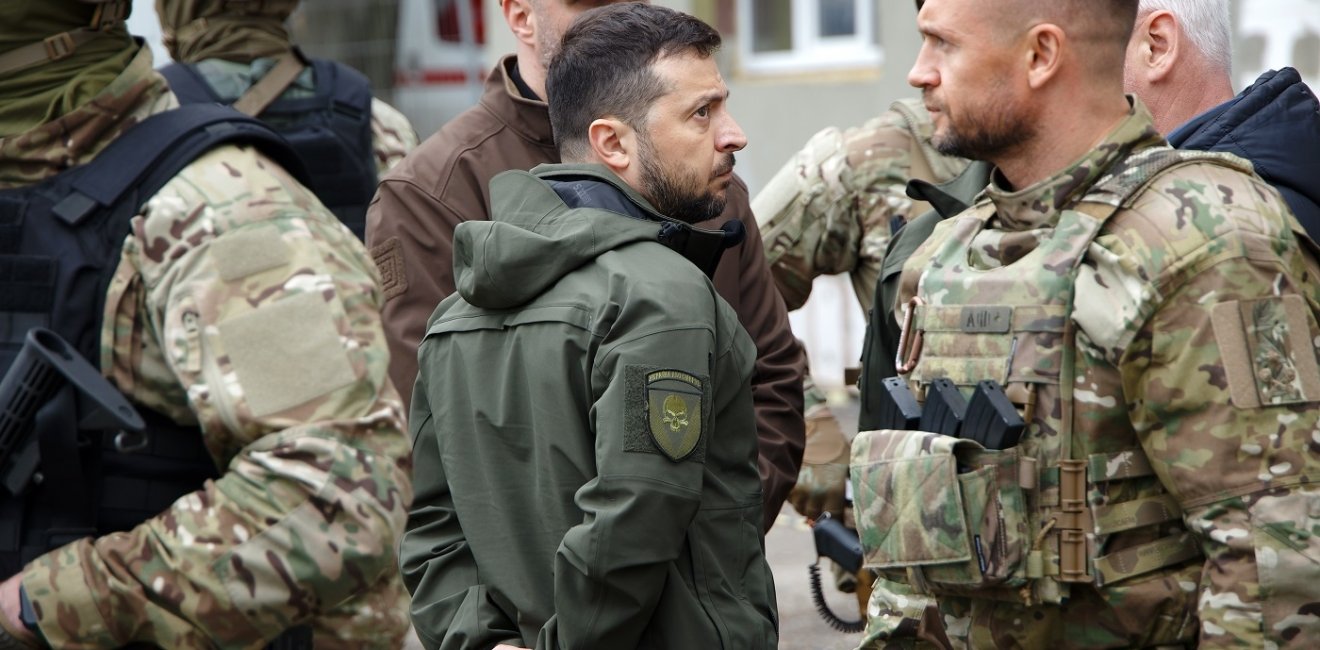
A blog of the Kennan Institute
Ukraine’s health is vital to Euro-Atlantic peace and security. The longer a full-scale war continues, the more problems deepen, and not only in the spheres of military risks and security. The growing political, economic, and environmental crisis in the region is producing separate but related problems. The sooner Ukraine and its allies propose an effective strategy for ending the war in one form or another, the greater the chance of preserving at least some part of the pre-war order. This issue must be taken up at all levels as soon as possible.
Various proposals and strategies have been put on the table by Ukraine. Is any actionable? What are the barriers to implementation?
Ukraine’s Official Strategy
Kyiv’s official strategy regarding conditions for ending the war was announced back in September 2022, at the height of the counteroffensive operation in southern Ukraine. This was the draft Kyiv Security Compact agreement, which was prepared on behalf of President Zelensky by Andriy Yermak, head of the Office of the President of Ukraine, and Anders Fogh Rasmussen, former head of NATO.
The draft agreement calls for the world to commit to years of sustained investment in Ukraine's defense industrial base, large-scale arms transfers, intelligence assistance, and intensive training missions under the supervision of the EU and NATO. The draft agreement also voices the need for tough, long-term sanctions against Russia and Belarus. It appears to anticipate a lengthy conflict, during which Ukraine will need sustained, reliable support.
The Kyiv Security Compact draft agreement was received with enthusiasm by many countries. At the NATO summit in Madrid in June 2022, the communiqué specifically stated that Ukraine is vital for the stability of the Euro-Atlantic region. That is why, the summit communiqué said, “with the support of key guarantors, Ukraine should be able to develop a reliable system of defense of its territories, focused on deterrence and successful defense against acts of aggression.”
The world received Zelensky’s “peace plan” with hope so long as Ukrainian soldiers on the battlefield showed impressive results, especially after the liberation of Kherson, the largest city in the South, in October 2022.
Zelensky’s Peace Formula
Now the President’s Office and leaders in diplomatic circles are increasingly talking about something else, the “peace formula.” Zelensky presented it during the G20 Leaders' Summit in Indonesia on November 15, 2022. This formula lays out Zelensky’s ideas about how Ukraine’s partners could respond to the crisis.
The key points of the formula are the all-for-all exchange of prisoners, the return of deported children, Russia’s recognition of the integrity of Ukraine, the restoration of Ukrainian control over all territories, and the withdrawal of Russian troops.
The country’s partners, the peace formula recommends, should support Ukraine’s efforts on the battlefield, help with modern weapons delivery and investments in Ukraine’s military industries, and provide more military and humanitarian aid. At the same time, they should activate more diplomatic and economic tools to further weaken Russia.
All these stipulations are supported by the vast majority of Ukrainians.
The peace formula appears to be organized around a moral point viewed as non-negotiable by both Ukraine and Moscow, Ukraine’s retention of all the territory within its pre-2014 borders versus Russia’s retention of territories it has taken over, which will be a barrier to its implementation. The Crisis Group has taken note of this impasse while finding that Ukraine’s no-compromise position may be unrealistic. It recognized in a July 2023 report that no senior Ukrainian official or military figure has advocated for a compromise.
However, many observers outside Ukraine consider such a formula unrealistic. It cannot become the basis for potential negotiations on a ceasefire, much less a peace agreement, because a no-compromise position precludes any number of compromise solutions that might be proposed by Ukraine’s allies and partners.
Contemporary Threats to Enacting the Kyiv Security Compact and Zelensky’s Peace Formula
Both the Kyiv Security Compact and the peace plan are predicated on Ukraine not losing the war outright. The robust talk of victory earlier in 2023, however, changed radically with Russia’s blowing up the Kakhovka Dam on June 6, 2023. In the Ukrainian army's counteroffensive strategy, crossing the Dnipro was a key step toward retaking Crimea, and the Russian command knew it.
The consequences of blowing up the Kakhovka dam are difficult to tabulate, but the most immediate consequence for military strategy is that it stopped the advance of the Ukrainian army to the south. Ukraine lost the strategically important city of Bakhmut in the Donbas just before that, in May 2023, and is now on the verge of losing Avdiivka, another important city in the east of the country.
If Russia captures Avdiivka, other strategically important cities, in which the main strongholds of the Ukrainian Armed Forces are located, may fall. Prominent Ukrainian military officer Maria Berlinska, who is developing drone tactics on the front lines, said recently that the situation is so bad that she would describe it as a defeat.
Ukrainian Society Is Exhausted
Under such conditions, discussing any of the ideas in the peace formula is difficult. But this time, unlike at the beginning of the invasion, after almost two years of hard fighting and tens of thousands of Ukrainians dead or injured, the population is exhausted. The psychological toll of the war is also affecting defense capability.
Ukraine is also churning through its fighting-age population, bringing the potential for a war of attrition into stark relief. Men aged 18 to 60 years are prohibited from leaving Ukraine without special permission, so families with children under 18 are moving abroad. These and other demographic processes directly affect both the economy and the country’s defense capability.
The problems that a protracted war creates are deepening divisions in society and provoking new ones. Holding parliamentary and presidential elections in 2024 could change the situation by encouraging new actors to step up and propose alternative visions, but insofar as almost a third of the territories of Ukraine are occupied, many deoccupied territories are unstable, and Russia continues to shell different parts of the country on a daily basis, free and fair elections are impossible and would not be representative under any meaning of the term.
The Search for a Realistic Strategy
In 2024 the world will be even more stormy. Elections are ahead in most NATO member countries, whose votes are decisive in shaping international politics and in providing humanitarian assistance. In addition to the United States, presidential elections will be held in the UK, France, and Germany—to date strong supporters of Ukraine—as well as in Russia and Belarus. The continued provisioning and funding of Ukraine in a war it did not seek is likely to be a key issue for politicians, especially those from the radical right and the populist parties.
Political manipulation of electoral sentiment may also be accompanied by real actions, such as reducing or completely withdrawing military assistance or financial support. All this will directly affect the residents of Ukraine and may end in “peace enforcement,” which may mean leaving occupied territories to Russia and freezing the war. The question of Ukraine’s survival in worst-case scenarios will be the number one issue in 2024.
In such a situation, a vision for ending the war becomes even more critical. An unrealistic strategy can lead to loss of partner support and global disappointment. However, this does not mean that Ukraine should abandon Zelensky’s peace formula.
The representative of Ukraine’s president in Crimea, Tamila Tasheva, explains that it is a mistake to believe that the “Crimea compromise,” which would allow Crimea to remain officially in Russian hands, would ensure peace, for Russia has extensively militarized the peninsula and the adjoining sea.
“The liberation of Crimea is a prerequisite for security in the Black Sea region,” she says. “At the same time, we understand that this war will most likely end in a peace treaty. A possible legal mechanism for ending the war will be a multilateral agreement, one that involves not only Ukraine and Russia but also the guarantors of security in the region, with ratification of the agreements at the level of their parliaments.”
Ukraine right now needs a fresh vision and strategy for ending the war in order to avoid a worst-case scenario in the near future. Its partners must come to the table with concrete proposals and guarantees of economic, political, and security support. And this task should have been done yesterday.
The opinions expressed in this article are those solely of the author and do not reflect the views of the Kennan Institute
Author


Kennan Institute
The Kennan Institute is the premier US center for advanced research on Eurasia and the oldest and largest regional program at the Woodrow Wilson International Center for Scholars. The Kennan Institute is committed to improving American understanding of Russia, Ukraine, Central Asia, the South Caucasus, and the surrounding region through research and exchange. Read more

Explore More in Focus Ukraine
Browse Focus Ukraine
Talking to the Dead to Heal the Living

Ukrainian Issue in Polish Elections


